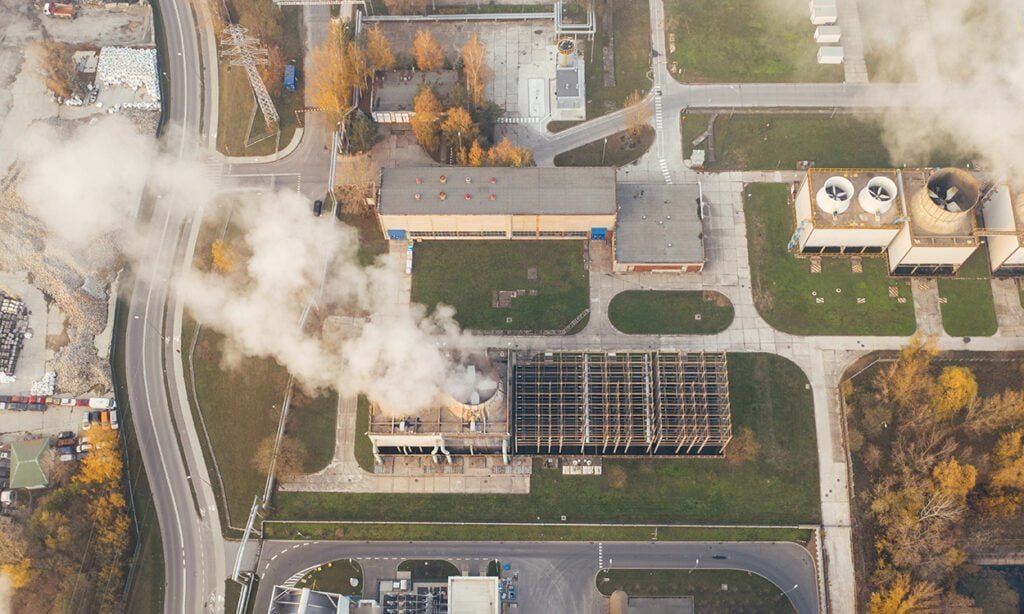Table of Contents
Introduction
What Is a Building’s Carbon Footprint?
Definition
In general, a carbon footprint is the total amount of greenhouse gases (such as carbon dioxide and methane) produced by our actions.

What Do Recent Statistics Say?
The average carbon footprint worldwide is closer to 4 tons. The world has a CO2 emission capacity of over 2.4 million pounds per second, with some of the highest emitters being European nations. Every day, each person in the UK uses 4,645 litres of water, which results in 3.68 million tonnes of CO2 annually from the supply and treatment of our water. The United States has the highest per capita carbon footprint, which is 16 tons on average.
The statistics are available here.

What Impact Does It Have on the Built Environment?

Immediate Effect
A single person or a small group of people may be impacted by the short-term effects. A small virus can quickly affect people and then the entire world, as was seen in the last three years of the deadly COVID-19 pandemic.
In similar ways, our carbon footprints as humans are being left all over the planet, which has a detrimental effect on the environment in numerous ways. Our ecosystem includes us, and everything in it is interconnected.
Additionally, every one of our actions triggers a series of events that have an impact on the planet and our continued habitation to it. Recent studies suggest that the harmful effects of gases with short lifetimes, like methane, may last longer than previously believed.
Food and water shortages are among these effects, which interfere with people’s daily lives everywhere but especially in low-income households.
Extended Effects
Melting of Polar Ice and Glaciers
Polar regions are under more threat as a result of the rising global temperature brought on by increased carbon emissions. Extreme wildfires and alarmingly high temperatures that released 56 megatonnes of carbon dioxide into the atmosphere happened in the Arctic last month. The ice sheet moreover lost a significant quantity of mass. For more details, see “The Carbon Story of a Melting Arctic.”
Air Pollution in Cities
Many research projects have been launched in the United States and other countries, focusing on tracking variations in atmospheric carbon dioxide (CO2) and connecting them to carbon emissions from cities. Such urban carbon research efforts create opportunities for stakeholder engagement and guidance on other environmental issues, like air quality, because carbon emissions are closely linked to socioeconomic activity through the combustion of fossil fuels, and many cities are actively adopting emission reduction plans.
Hazardous Acid Rain
It becomes a major issue when SO2 and NOX interact with sulphate and nitrate particles in the atmosphere. Asthma, bronchitis, and even cancer are among the health problems it affects people with. Massive amounts of sulphur dioxide (SO2) and nitrogen oxides (NOX) are released into the atmosphere when fossil fuels are burned in power plants.
Catastrophic Weather Conditions
According to NASA, there may be an increase in tropical storms, droughts, and wildfires as a result of global warming. Human health issues are brought on by infrastructure destruction, including diseases that are spread when sewage and water systems aren’t functioning properly. A great deal of human life is frequently lost as a result of storms themselves and the harm they inflict on infrastructure.
Geographical Changes
The fact that elevated levels of CO2 in the climate cause it to warm up is now widely accepted. Sunlight heat that would oppositely shun into space is absorbed by CO2. Some of this energy is returned to Earth and contributes to further warming of the planet. Since the middle of the 20th century, there has been a significant rise in global temperatures, with an increase of about 0.7°C from the baseline. Temperatures were an additional 0.5°C colder when looking back in time. This results in a 1 °C increase in the average temperature overall.
Architectural Factors Influencing the Carbon Footprint
Major Contributors
Impact of Industrial Activities
Concerns about the viability of the environment have grown over the past few decades as a result of population growth that is outpacing the growth of the architectural industry, and these concerns have increased awareness of the factors that influence pollution from major industries. The relationship between environmental deterioration and industrial architecture activities has thus been examined by a variety of academics.
Constructional Pollution
In both urban and rural areas, construction sites can be seen frequently not far from dwellings. Construction sites may pollute homes because of their proximity to them and the materials they use. Also contributing to air, water, and noise pollution are these activities’ use of toxic materials, the use of diesel engines, and the demolition, burning, and clearing of land.
Unthoughtful Architecture
Some designers are occasionally ignorant of the realities of the context in which their work is performed. As a society, we should set standards for architectural designers to be sustainable—not just from an environmental and energy-saving standpoint but also from the standpoint of usability and realism.
Minor Contributors
The Daily Needs of Society
Food contributes between 10 and 30 percent of a household’s carbon footprint, with lower-income households typically contributing more. A vegetarian diet significantly lowers one’s carbon footprint, but switching to less carbon-intensive meats can also have a significant effect. Other concerns include household electricity, heating, cooling, and personal transportation systems.
Is the Direction of Education Incorrect?
The stated goal of the Belgrade Charter was to “develop a world population that is aware of and concerned about the environment and its associated problems, and that has the knowledge, skills, attitudes, motivations, and commitment to work both individually and collectively toward solutions to current problems and the prevention of new ones.”
The Carbon Footprint of an Individual
One could argue that each person has a responsibility to contribute to the reductions required for stabilization below risky levels. Reduced use of air conditioning and heating, LED lighting, recycling, washing clothes in cold water instead of hot water, and forgoing the dryer are all examples of ways to cut back on energy consumption in a home.
Another adjustment would be to rely less on motor vehicles that use gas combustion as their power source. By using direct flights when flying, one can also reduce their carbon footprint. While making these changes won’t immediately reduce one’s carbon footprint, they will have a significant impact in the long run.
Carbon Footprint Reduction Through Sustainable Architecture
What is Sustainability?
Environmental concerns and sustainable architecture are now on the corporate, national, and international communities’ agendas. Furthermore, it is in high demand. The terms “sustainable architecture” and “sustainability” are becoming more popular in the design and architectural communities for two reasons: functional and formal. Any product that wants to be regarded as sustainable needs to demonstrate ecological awareness, so its functionality needs to be connected to how it interacts with the environment through its aesthetics.
So, if you examine a building’s architecture carefully, you’ll see that there are various building types. For example, there are energy-efficient buildings, which emphasize how good they are on energy, and environmentally friendly buildings, which emphasize other factors besides energy.
Why is it important?
As we have seen in the overall, more general definition of sustainability, it refers to preserving resources and maintaining the natural balance for present-day populations as well as for future generations. Reducing energy use and waste generation is just one aspect of sustainable architecture. It cannot be broken down into different subcategories because it represents an intrinsic and essential combination of factors related to our existence on this planet. It is crucial that we make sure the building’s design has the least detrimental environmental impact possible.
Sustainable Design Methods in Architecture
A few fundamental factors must be taken into account when designing sustainable architecture, including orientation, natural ventilation, the use of biomass, and shading and sunlight created by pre-existing elements. In order to create and incorporate all of these elements, materials that are intended to interact with the environment and its features are used.
Get Inspired by Nature
It has become crucial for architects and builders to invest in natural climate solutions. Considering that Indian households’ carbon footprints can be reduced by up to 20% by using natural ventilation rather than air conditioners. Numerous methods exist to accomplish this.
In order to maximize surface exposure to prevailing winds, the building should first be oriented. To make the structure more wind-resistant, you could also try raising it on stilts. You can also try raising the building on stilts as it will catch more wind. A veranda open on three sides is preferred as it increases room air. motion in the room with respect to the outdoor wind, for most orientations of the building.
Another way to significantly reduce the carbon footprint value is to utilize the local vegetation to the fullest extent possible.
Ecosystem Health in Architecture
In cities today, the need to reconnect to nature through ecological architecture stems from the need to preserve the natural environment and mitigate the detrimental effects of human dominance over nature.
Energy Efficiency in Residence Design
We must actually strive for water and energy efficiency. In recent years, water has become one of the most in-demand natural resources. As a result, we are witnessing various crises, such as the lack of water during the summer and other typical months, as well as decreased material efficiency. Of course, we can reduce costs by reducing bulk, manufacturing costs, and resource costs directly. Consequently, there are several benefits to actually utilizing these techniques and strategies: –
- Site selection that is appropriate
- In plantations, tall trees and ground-covering shrubs, trees, and vines should be planted to shade roofs and lower temperatures.
- Use the slopes on a hilly site that faces north or south whenever possible.
- Taking proper solar angles into account
- enabling or disabling wind as necessary.
Sustainable Building Materials
So let’s examine the actual provisional selection criteria. We are looking for qualities like durability, ecological impact, embodied energy, performance, social impact, cost, non-toxic or less-toxic materials, renewable energy, and biodegradability, in addition to those that are obviously important in terms of aesthetics.
Natural materials made from bio-based materials have 20% better insulation qualities than artificial materials like fiberglass. Fly ash, red mud, slag, unfired clay bricks, manufactured sand, glass, and several other items on the list of materials that can be used are things that we are all familiar with and are being acquired in current times in the construction business as alternative materials.




